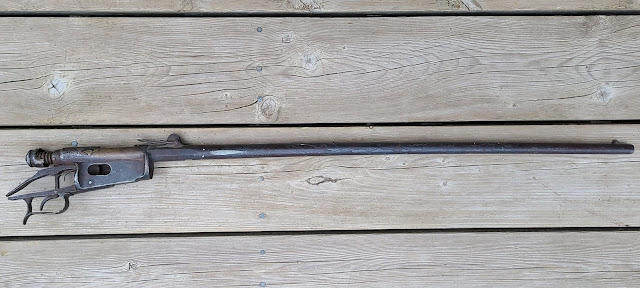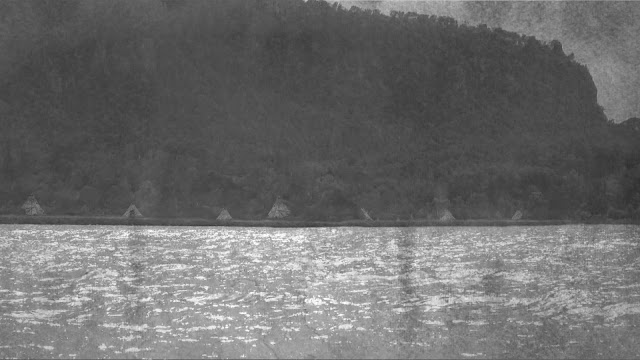152 Year Old Mystery Rifle Dug Up In Red Rock
During the early days when Red Rock was still a growing and developing community, land was being prepared for new homes and many other establishments, and the road to Red Rock was no exception. Many homes began to dot the future highway 628, places where there was still virgin soil, never once over turned by man or machine. However, one lot of land, or rather the content excavated from the lot of land, (which was about a half mile west of Red Rock,) became the focus of curiosity for one man for the last 67 years.
Laurie Bellamy was 5 years old when he came to Red Rock in 1947 and has lived here his entire life. I would speak with him time and again, he would always be inquisitive as to what I would be writing for my next installment in the Dark History Blog, as he knows I cover not just the paranormal, and legends of our area, but basically give history lessons for my online readership. On July 2, 2021 he stopped and told me a very interesting story while I was on my daily walk, about a mysterious discovery made on the Red Rock Road in 1953 or 1954.
The Department of Veteran’s Affairs had granted money to have a house built for (we’ll call him) WF. During this time; while a machine was excavating a basement on the lot, a group of boys had come down the road on their bicycles. Laurie and his friends decided to stop and watch the machine dig. It was then the bucket came up unearthing something very strange. It wasn’t a weird shaped root, or an old log, but it looked like a rifle! As the bucket emptied and started over for another load of gravel, he quickly dropped his bike, ran over and snatched up the incredible find.
“They were digging and putting the earth there, and I seen it come up, and I went and grabbed it and took it. I said, ‘I’m taking this home.”
He believed it would have been covered over and pushed into the woods as no one else but they had seen the rifle. If they had not been there to witness this, no one would have ever known about it. The weapon is a mystery to some degree as he has surmised it was a rifle from the North-West Rebellion. Troops had crossed the many gaps in the CP Rail line in 1885 and had one final crossing. The knee high slush on Nepigon Bay from Kama to Red Rock in April that year on their way to Qu’Apelle, Saskatchewan. Yes, even then the future townsite was called ‘Red Rock’ as Chief Tawagnum (Drum) had named it for the red Cuesta on what would be the highway northwest of the town.
During April 1885, for a 2 week period, a half cord to a full cord of wood was chopped, and burned upon the hill at Red Rock (overlooking the trackless CPR) as a beacon light for men and horses to slog their way over. Likely lit at what is now the Nipigon River Recreational Trail, Lloyd’s Lookout in particular. A period drawing shows the men from that vantage point as they crossed to and fro with their baggage and supplies. The men, exhausted and chilled to the bone made their way on to the trains and collapsed every which way in the seats and slept past their suppers, incapable of being awakened. From beginning to end, March 30 - May 16, 1885 men made their way across both day and night, sun and freezing rain to reach the trains.
On Monday March 30, 1885, John Ross mentioned having the 1st detachment of 200 Artillery loaded by Friday evening April 3, while J Niblock made mention of putting down some rails at a small siding that was here, about half mile west of Red Rock, however decided not to. The men caught the trains where the line picked up again which was directly parallel where the future highway would be, and in all likelihood where the future home would be. The home is located a mere 180 feet from the CPR track. It’s easy to imagine lines of troops boarding the awaiting passenger cars, as well as the horses, food, baggage, and weapons being loaded from here too.
As mentioned earlier, this was virgin soil, nothing had ever been dug here, not even a plow run through. The only work that would have been done on this property was tree removal. This weapon, a mystery for 67 years (to the then 12 or 13 year old Laurie), was unearthed somewhere within a 10 foot deep hole, which had not seen the light of day since settling into the ground. Over the years he has questioned how it even got there. Was it thrown there? Was it lost? Was it just a broken rifle with no time to fix it? Was it left on purpose for future generations in hopes it would be found? It seems the likelihood of never being found would be 99% yet through some strange twist of fate, here it is. This brings to mind another question, was it possibly hidden on purpose? And then why? All questions he has pondered over the years. Who knows, maybe it was previously owned by a farmer/ settler in the area, and then just left in the woods to rot due to it’s broken (and missing) bolt. It also may be possible it was left by a voyager in the area, as there were remnants of voyageur encampments found at 5 mile point beside the Red Rock Mill. In retrospect it could also be a rifle from the men working on the railroad, kept for their own safety against the bear population in the area.
The weapon, now 152 years old may not be a museum piece, yet could bare historic significance, if in fact it could be linked in with the soldiers set out to quell the rebellion. The weapons used in the war were Snider Enfield Rifles, Martini Henry Rifles, 9 lb field guns, carbines and a Gatling gun. Also used by some members were ancient “Peabody” rifles which still surprisingly fired. However not listed anywhere in the army’s arsenal were the Swiss “Vetterli” Rifles which were used by the Swiss Army from 1869-1889 and known as one of the most advanced rifles in Europe of that time.
About the rifle:
W. von Steiger Thun
Model 186971 Bolt Action Rifle
Swiss Vetterli M1869/71
Made in Switzerland: Bern, Thun - (formerly von Erlach und Cie.)
Date of Manufacture: 1871-1874
Serial Number: 104089
Designed by Johann-Friedrich Vetterli Manufactured in Bern
Other information:
Barrel length: 33.1 inches
Overall Length: 51.2 inches
Weight: 10.4 lbs empty
Chambering: 10.4x38 (.41) Swiss Rimfire
Rifling: 4 groove, RH Twist, 1 in 26”
Velocity: 1425 feet per second
Capacity: 12 (11 round tubular magazine + 1 in the chamber)
Sights: Iron
The updated 1869 model of 1871 featured an improved elevator system and simplified receiver. The loading gate and magazine cut off (previously appeared on the left side of the receiver) were removed. It featured a modified loading mechanism as well. In time, several mods were made to the 1869/71 Vetterli such as tighter barrel tolerances, ejection port cover removal, front and rear sight improvements and omission of the gas escape holes above the chamber.
When looking into further details of the rifle, I couldn’t find any information when inputting the number into several databases. (Note: no serial number recorded for this particular weapon, closest numbers were 1039xx & 1049xx.) As for the number of rifles manufactured, there appears to be 36,700, yet another website tapatalk says WV Steiger Thun only produced 200 rifles. I believe each manufacturer was allotted a number of rifles and accompanying serial numbers to produce. Even at 200 rifles produced, it seems impossible to find the man to whom this weapon would have belonged, as it was so many years ago. It may not have been a weapon used in the North West Rebellion, but more likely a firearm from either the voyageurs, fur traders, trappers, or even a farmer in the area, as the men who were sent to fight the in the rebellion were given army issue weapons, and the type of weaponry used seem to be historically accounted for.
It was also mentioned in theory that the men who crossed from Kama to Red Rock in 1885 may not have been just Army troops, but Swiss mercenaries as well, however I could not find any record of this being the case. The North-West Field Forces sent to fight were from Ontario, Quebec and Nova Scotia, made up of the Regiment of Canadian Artillery A Battery (Quebec) B Battery (Kingston) Infantry School Troops C Company (Toronto) 2nd and 10th Battalion Royal Grenadiers (Toronto) Midland Battalion (Kingston) York and Simcoe Battalion (Toronto) Governor General’s Foot Guards (Ottawa) One Company Sharp Shooters (Ottawa) 7th Battalion Fusiliers (London) Governor General’s Body Guard (Toronto) 65th Battalion Royal Rifles (Montreal) 9th Battalion (Quebec), Cavalry School Corps “A” Troop (Quebec) Halifax Provisional Battalion ((Halifax) Gatling Battery Montreal Garrison Artillery (Montreal) Altogether numbering 3,293 including Officers.
It seems the rifle find, to be added in along with a musket ball at Nipigon, a cannon ball also of Nipigon, and an old rifle found on the beach at Lake Helen (so I am told) all make for untold histories full of mystery as to how each got there, will go unanswered fully for their owners. The rifle, a fine piece of military craftsmanship has made an excellent addition to Mr. Bellamy’s various historical artifact collection. Pretty cool.
 |
| Laurie Bellamy |
In closing, we will never know everything that lies just beneath our feet in the multi-faceted layers of history. And when something is happened upon, it adds to our communities timeline, edging us just a little bit closer to the unspoken, inescapable truth of history our forefathers knew, and we are only now just learning of.
~ Dee McCullay - Dark History









Comments
Post a Comment